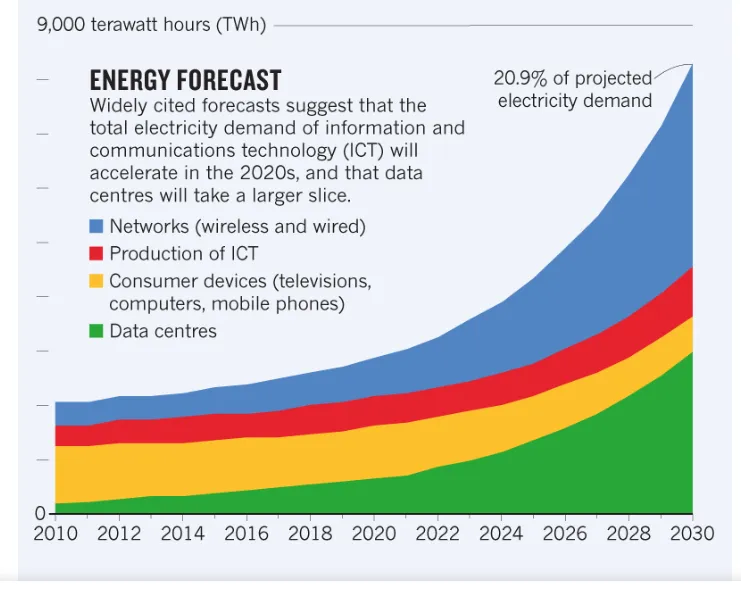The (more) Sustainable Data Center
Blog: Capgemini CTO Blog
When the music video “Despacito” was released it became the first video that hit 5 billion views on YouTube. The lead scientist, Rabih Bashroush calculated that downloads consumed as much as energy as 40,000 U.S. homes use in one year. [11]
Data Centers use an estimated 200 terawatt hours (TWh) each year. This is more than the annual energy consumption of some countries. They contribute around 0.3% to overall carbon emissions, while the information and communications technology (ICT) ecosystem as a whole accounts for more than 2% of global emissions [8].
But ICT power consumption is predicted to balloon to 20% of global electricity demand by 2030, which would mean a greatly increased carbon footprint. Something must be done.

Doing something
In 2008 Capgemini decided we had to significantly improve our data center sustainability in the UK. When our new data center, Merlin [4], came online in 2010 it set a new global standard for energy efficiency, with an industry-leading Power Usage Effectiveness (PUE) rating.
Among Merlin’s sustainability achievements are:
- An expected PUE of 1.10
- A fresh-air cooling system that delivers 80% savings in run costs and produces up to 50% less carbon emissions
- Developing Merlin on a brownfield site to avoid unnecessary construction activity
- Using renewable power provision to reduce carbon emissions
- Constructing modules with 95% recyclable materials
- Using cleaner flywheel energy storage technology instead of environmentally damaging batteries.
- Power savings of 91% compared to an industry average data centre (with a PUE of 2.5)
Power Usage Effectiveness
PUE is a widely accepted measure of data center power efficiency, calculated by dividing power delivered to the facility by the power consumed by the IT equipment. It was first established in the late 2000s and is now ISO/IEC standard: 30134-2:2016.
In 2007 the data center industry average PUE was ~ 2.5. Today it is 1.6 [10]. There is an industry-wide effort to reduce this, with a target of around 1.3 PUE [2] but only a handful of providers have achieved a PUE of less than 1.2. For instance according to their own figures, Google’s E data centre achieved 1.12 PUE back in 2009 [2],[3],[7] and HP’s Wynyard facility is at 1.16 PUE. Google claims that all its data centres are now near the 1.1 mark [3].
Our Merlin data center uses a fresh air-cooling system that is a real green innovation, improving both resource and power efficiency. Merlin also replaces polluting battery-based UPS systems with flywheel energy storage, which is something the industry should have addressed long ago.
In controlled factory testing, Merlin data center modules achieve a PUE of 1.08. Under operational conditions, adding in electrical and UPS losses, we fully expect to achieve a data center PUE of 1.1.
Designing in sustainability
Achieving sustainability means addressing environmental considerations during solution design as well as during the build. Solutions must meet pre-defined and agreed environmental sustainability criteria.
Vendors typically provide calculators to help designers achieve total power consumption goals for servers, storage, and network equipment. Examples include HPE, for their ProLiant DL380 Gen9 series [5], and Dell’s Enterprise Infrastructure Planning Tool (EIPT) [6].
EIPT can model a full rack with any (technically) possible server, storage, and network equipment and calculate the power usage in watts per hour. To calculate total power consumption, you simply multiply this result by the hours in use.
The environmental impact of the production of the equipment to be used should also be considered. Many vendors publish their equipment’s production footprints to help with this factor.
The solution architect’s responsibility
Minor changes to the logical design of a solution can have significant sustainability implications, for example by adding new physical components or changing performance characteristics. Non-functional requirements (NFR) are important during the design phase, and it is the solution architect’s job to consider all of them, including sustainability:
- Scalability: Ensure the solution supports the current and projected business volumes.
- Reliability: Ensure the solution provides an appropriate level of robustness in support of business processes.
- Manageability: Ensure the solution can be managed and maintained efficiently and effectively.
- Availability: Ensure the solution provides the required levels of service as well as performance characteristics.
- Sustainability: Ensure the solution meets or exceeds the agreed environmental sustainability targets (energy consumption as well as supply chain and waste).
- Security: Ensure the solution provides all security related measures and controls to minimize security related risks.
The environmentally friendly disposal of equipment that reaches the end of its service life must also be considered. The environmental sustainability of a data center starts with the production of the equipment, continues with efficient operation during its “production” life and end with the safe, secure, and environmentally friendly disposal of equipment and any auxiliary components.
Summary: We are all responsible for ensuring that the solutions we design consider environmental factors and sustainability. One key area is the design of data centers and the power consumption of the physical equipment they use. As solution architects and designers we are accountable for this, and it is our duty to ensure we take it seriously.
References:
[1] https://www.capgemini.com/wp-content/uploads/2019/06/Capgemini-Environment-Report-18-19.pdf
[2] Google Efficient Data Centres web resource and research: https://storage.googleapis.com/gweb-sustainability.appspot.com/pdf/24×7-carbon-free-energy-data-Centres.pdf
[3] 1st April 2009: Google disclosed an average PUE for its six company-built data centres of 1.15 in Q1 2009. According to Google’s Chris Malone, the most efficient individual data centre (described as “Data Centre E”) has a PUE of 1.12
[4] https://www.capgemini.com/gb-en/wp-content/uploads/sites/3/2017/07/Merlin_____the_World___s_Most_Sustainable_Data_Centre.pdf
[5] https://support.hpe.com/hpsc/doc/public/display?docId=emr_na-c01510445
[6] http://dell-ui-eipt.azurewebsites.net/#/
[7] European data centres How Google’s digital infrastructure investment is supporting sustainable growth in Europe https://storage.googleapis.com/gweb-sustainability.appspot.com/pdf/Google_EU-DCs_Report.pdf
[8] https://www.iea.org/reports/digitalisation-and-energy
[9] How to stop data centres from gobbling up the world’s electricity, Sep 2018, nature.com https://www.nature.com/articles/d41586-018-06610-y
[10] https://www.csemag.com/articles/reduce-pue-to-unlock-capacity-in-data-Centres/
[11] https://www.bbc.co.uk/news/technology-45798523
